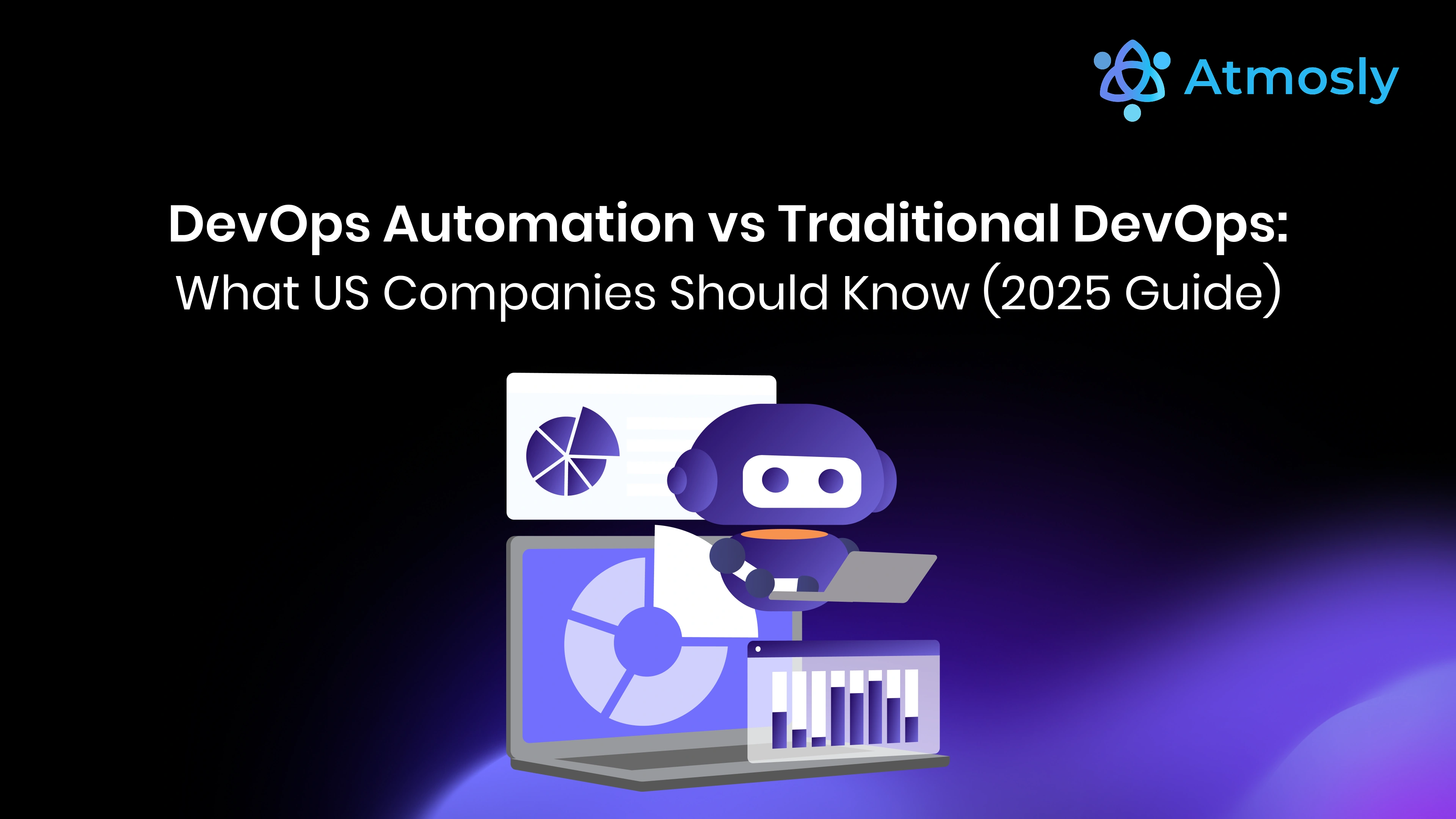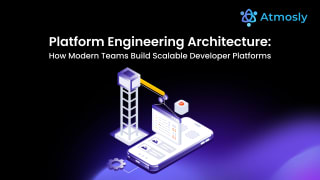Over the past decade, DevOps has transformed how software is built and delivered. US companies from Silicon Valley startups to Fortune 500 enterprises have embraced DevOps to accelerate releases, improve collaboration between development and operations, and deliver higher-quality software at scale.
But DevOps itself has evolved. While the traditional model helped break down silos and improve delivery speed, it often still required manual steps, patchwork toolchains, and human approvals, slowing workflows. As businesses in the US face rising competition, stricter compliance regulations, and increasing pressure to innovate faster, DevOps automation has emerged as the natural next step.
This article compares traditional DevOps vs DevOps automation, explains why US companies are moving toward automation, and provides practical guidance on adoption. By the end, you’ll know exactly which approach is right for your team and how platforms like Atmosly can help US businesses modernize their DevOps practices.
1. What is Traditional DevOps?
When DevOps first gained traction in the early 2010s, it was revolutionary. By bringing developers and operations teams together, organizations could shorten release cycles and reduce friction. Traditional DevOps introduced practices such as continuous integration (CI), continuous delivery (CD), and infrastructure as code (IaC), using tools like Jenkins, Ansible, and Terraform.
1.1 Strengths of Traditional DevOps
- Improved Collaboration: Developers and operations worked more closely than in siloed models.
- Faster Releases: Automated builds and tests reduced release times compared to pre-DevOps.
- Adoption of IaC: Tools like Terraform enabled codified, repeatable infrastructure.
1.2 Limitations of Traditional DevOps
However, as US companies scaled their software operations, cracks began to show:
- Manual Intervention: Many workflows still require human approvals or manual scripts.
- Toolchain Sprawl: Jenkins for CI/CD, Ansible for configuration, Nagios for monitoring, stitching tools together created complexity.
- Scaling Challenges: Adding more engineers often led to greater complexity rather than greater efficiency.
Security Gaps: Security checks were bolted on late in the pipeline, delaying releases.
Example: A mid-sized SaaS company in Austin using Jenkins pipelines with manual QA approvals might release every two weeks. While faster than older models, it still falls short of competitors that deliver daily.
2. What is DevOps Automation?
DevOps automation builds on traditional DevOps practices but goes further by removing manual steps and human bottlenecks. It leverages modern tooling, AI, and orchestration to automate the full software lifecycle.
2.1 Core Components of DevOps Automation
- Automated CI/CD Pipelines: Code commits trigger builds, tests, and deployments automatically.
- Infrastructure Provisioning: IaC tools automatically spin up environments on AWS, Azure, or GCP.
- Security & Compliance as Code: Policies for SOC 2, HIPAA, or PCI are embedded directly into pipelines.
- AI-Driven Insights: Copilots diagnose pipeline failures, optimize Kubernetes clusters, and suggest fixes.
- Cost Optimization: Platforms provide dashboards to monitor and control cloud spend.
2.2 Example in Practice
A fintech company in New York using automated pipelines can push secure, compliant updates multiple times per day. Security scans, compliance checks, and monitoring are automated, allowing engineers to focus on innovation rather than repetitive tasks.
3. DevOps Automation vs Traditional DevOps: Key Differences
Here’s a side-by-side breakdown of where the two approaches diverge.
3.1 Speed of Delivery
- Traditional DevOps: Manual QA, approvals, and patchwork tooling slow down releases.
- DevOps Automation: Fully automated pipelines enable daily or even hourly releases.
Example: A SaaS company in San Francisco using automation deploys 20+ updates per day, while a competitor on traditional DevOps ships only once per week.
3.2 Scalability
- Traditional DevOps: Scaling often means hiring more engineers.
- DevOps Automation: Automation scales with tooling, allowing leaner teams to manage larger workloads.
3.3 Security & Compliance
- Traditional DevOps: Security added late in the pipeline, often delaying releases.
- DevOps Automation: Shift-left security code is scanned automatically at every commit, with compliance policies enforced as code.
This is particularly important in the US healthcare sector, where HIPAA compliance is non-negotiable. Automation ensures policies are always applied.
3.4 Cost Efficiency
- Traditional DevOps: Higher operational costs due to manual monitoring and cloud waste.
- DevOps Automation: Autoscaling, cost dashboards, and resource optimization reduce spend critical for US startups under investor pressure.
3.5 Toolchain Complexity
- Traditional DevOps: Multiple tools stitched together, requiring specialized expertise.
- DevOps Automation: Integrated platforms like Atmosly consolidate CI/CD, monitoring, compliance, and cost intelligence into one environment.
3.6 Team Culture & Roles
- Traditional DevOps: Collaboration improved, but developers still rely heavily on ops engineers.
- DevOps Automation: Developers are empowered with self-service infrastructure, reducing dependencies.
Comparison Table:
Feature | Traditional DevOps | DevOps Automation |
| Delivery Speed | Weekly/bi-weekly releases | Daily or hourly releases |
| Security | Manual, late-stage | Automated, shift-left |
| Compliance | Manual audits | Compliance-as-code |
| Scalability | More engineers required | Scales with automation |
| Toolchain | Fragmented, multiple tools | Unified, integrated platforms |
| Cost Optimization | Reactive, manual monitoring | Proactive, automated cost controls |
4. Why US Companies Are Moving Toward DevOps Automation
US businesses are leading the global shift toward automation-first DevOps. Key drivers include:
- Talent Shortages: The US faces a shortage of DevOps engineers, making automation essential.
- Compliance Pressure: Industries like healthcare, fintech, and government contracting must comply with HIPAA, SOC 2, PCI-DSS, and FedRAMP. Manual compliance is too slow.
- Faster Innovation: US startups thrive on rapid iteration. Automation enables speed without sacrificing quality.
- Cost Efficiency: With rising cloud bills, automation tools with cost intelligence are increasingly attractive.
Example: A SaaS company in Boston reduced cloud costs by 30% after adopting automated cost dashboards, allowing them to reinvest savings into product development.
5. Challenges in Adopting DevOps Automation
Transitioning from traditional DevOps to automation isn’t without challenges:
- Upfront Costs: Migration and tool adoption require investment.
- Resistance to Change: Engineers comfortable with traditional tools may resist.
- Integration Complexity: Migrating legacy pipelines to new automation tools is tricky.
- Vendor Lock-In: US companies often fear being tied to a single vendor’s ecosystem.
Best practice: Start small, automate one pipeline, and expand gradually to ease the transition.
6. Best Practices for US Companies Transitioning
If your US business is ready to move from traditional DevOps to automation, follow these steps:
- Start with CI/CD: Automate builds, tests, and deployments first.
- Integrate Security Early: Use tools that embed security scans in every commit.
- Consolidate Tools: Avoid toolchain sprawl by choosing integrated platforms.
- Focus on Compliance: Select automation tools that are SOC 2, HIPAA, and FedRAMP-ready.
- Train Your Teams: Invest in upskilling engineers for AI and automation-first workflows.
- Adopt Platforms like Atmosly: Atmosly reduces complexity with AI copilots, compliance automation, and cost dashboards tailored for US companies.
7. The Future of DevOps in the US: Automation-First
Looking ahead, DevOps in the US will be defined by automation.
- AI Copilots: Debugging pipelines, optimizing Kubernetes, and auto-suggesting fixes.
- Policy-as-Code: Compliance integrated into every stage.
- Internal Developer Platforms (IDPs): Developers get self-service infrastructure without deep DevOps expertise.
- Consolidation of Tools: Instead of managing 10+ tools, US companies will adopt platforms like Atmosly that unify everything.
By 2027, analysts predict that over 70% of US enterprises will rely on AI-driven DevOps automation platforms.
8. Conclusion
Traditional DevOps was a major step forward for software delivery, but for US companies in 2025, it’s no longer enough. The demand for faster releases, stronger compliance, and leaner operations requires automation.
- Traditional DevOps improved collaboration and delivery speed but still relies heavily on manual intervention.
- DevOps Automation eliminates bottlenecks, scales effortlessly, and ensures security and compliance by default.
For US companies, the question is not if they should adopt DevOps automation, but when. And the answer is clear: to remain competitive, the transition must happen now.
Platforms like Atmosly make this shift easier by offering a unified DevOps automation solution with AI copilots, compliance automation, and cost intelligence tailored for modern US businesses.
In 2025, the companies that thrive in the US market will be those that embrace automation-first DevOps.






